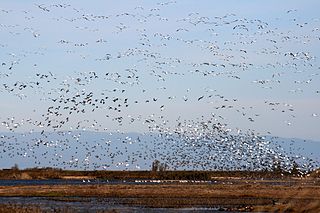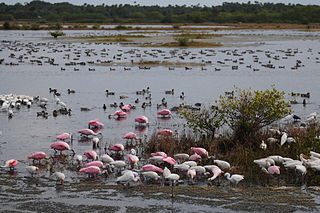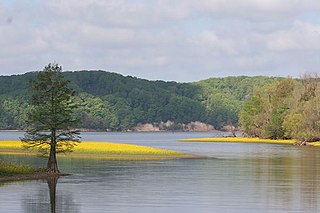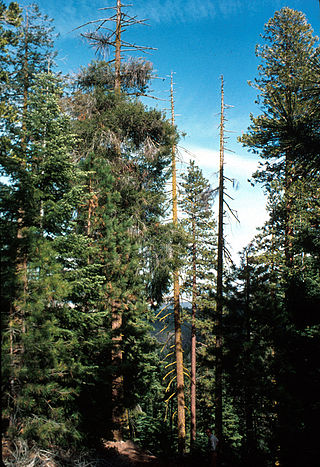Related Research Articles

The Sacramento National Wildlife Refuge Complex is part of the United States system of National Wildlife Refuges (NWR). It is located in northern California, in the valley of the Sacramento River.

Merritt Island National Wildlife Refuge is a 140,000-acre (57,000 ha) U.S. National Wildlife Refuge (NWR) on the Atlantic coast of Florida's largest barrier island. NASA's Kennedy Space Center and visitor complex are also situated on the island and NASA can restrict access to the refuge based on its operational needs.
The Wheeler National Wildlife Refuge is a 35,000-acre (142 km2) national wildlife refuge (NWR) located along the Tennessee River near Decatur, Alabama. Named after Major General Joseph Wheeler, it was established to provide a habitat for wintering and migrating birds in the Eastern United States.

The Baca National Wildlife Refuge is a 78,697-acre (31,848 ha) United States National Wildlife Refuge located in southern Colorado. It is within the Sangre de Cristo National Heritage Area.

Tennessee National Wildlife Refuge is a National Wildlife Refuge of the United States located along the shores of the Tennessee River in West Tennessee. It was established in 1945 where the impoundment of Kentucky Lake by the Tennessee Valley Authority has created a more-or-less permanent wetlands environment favored by many species of waterfowl. The entire refuge area is 51,359.46 acres (207.84 km²) in three units: From north to south they are Big Sandy, Duck River, and Busseltown.
Reelfoot National Wildlife Refuge is a part of the U.S. system of National Wildlife Refuges consisting of an area of Northwest Tennessee and Western Kentucky that consists primarily of a buffer zone around Reelfoot Lake, Tennessee's only large natural lake. It formed after the New Madrid earthquakes of 1811–1812 and is one of the Mississippi River Basin's richest locations for waterfowl, aquatic life, and other wildlife.

Cross Creeks National Wildlife Refuge is a part of the U.S. system of National Wildlife Refuges located along the Lake Barkley impoundment of the Cumberland River in Stewart County, Tennessee near Dover, covering 8,862 acres (35.86 km2). It provides habitat for a wide variety of waterfowl and aquatic plant life in what is a largely wetlands environment. Cross Creeks is the only National Wildlife Refuge located entirely in Middle Tennessee as of 2006.
Chickasaw National Wildlife Refuge is a 25,006-acre (101.20 km2) National Wildlife Refuge located along the Mississippi River in West Tennessee. The vast majority of the refuge is located in the northwestern part of Lauderdale County with small portions extending into southern Dyer County. The area is noted for a diversity of wildlife, notably white-tailed deer, wild turkey, beaver, and waterfowl. Established in 1985, it occupies land that was once owned by the Anderson Tully Inc of Memphis, Tennessee.
The Mark Twain National Wildlife Refuge Complex was established for the protection of migratory birds including waterfowl, shorebirds, and songbirds. It is located along the Mississippi Flyway, one of the major routes for migrating waterfowl. Refuge units also provide important habitat for big-river fish and a variety of other native wildlife such as deer, fox, beaver, frogs, turtles, and snakes. Key goals are to conserve and enhance the quality and diversity of fish and wildlife and their habitats, to restore floodplain functions in the river corridor, and to provide wildlife-related recreational experiences for the public.

The 30,843 acres (124.82 km2) Chassahowitzka National Wildlife Refuge is part of the United States National Wildlife Refuge System, located on the west coast of Florida, about 70 miles (110 km) north of St. Petersburg. It is famous as the southern wintering site for the re-introduced eastern population of whooping cranes.

The Crystal River National Wildlife Refuge is part of the United States National Wildlife Refuge (NWR) System, located in Kings Bay, in the town of Crystal River, and consists of 20 islands and several small parcels of land. The 80-acre (32 ha) refuge was established in 1983, to protect the West Indian manatee.

The Lake Wales Ridge National Wildlife Refuge is part of the United States National Wildlife Refuge (NWR) System, located in four separated areas on the Lake Wales Ridge east of US 27 between Davenport and Sebring in Florida. The 1,194 acre (4.8 km2) refuge was established in 1990, to protect a host of plants and animals. It is also the first to be designated primarily for the preservation of endangered plants, and is not open to the general public. It contains a high proportion of remaining Florida scrub habitat. It is administered as part of the Merritt Island National Wildlife Refuge.

The Passage Key National Wildlife Refuge is part of the United States National Wildlife Refuge (NWR) System, located offshore from St. Petersburg. The 64-acre (0.26 km2) refuge was established in 1905 by President Theodore Roosevelt to preserve nesting colonies of native seabirds and wading birds. The Passage Key Wilderness Area is part of the refuge, and consists of 36.37 acres (0.1472 km2) of its total area. It was established in 1970, to protect native birds and serve as a breeding ground for them.

The Rappahannock River Valley National Wildlife Refuge is a National Wildlife Refuge in Warsaw, Virginia, United States that was established in 1996. It is managed by the United States Fish and Wildlife Service.

The Upper Klamath National Wildlife Refuge is a wildlife refuge in southwestern Klamath County on the shores of Upper Klamath Lake in Oregon. It was established in 1928 and contains some 14,400 acres (5,800 ha) of freshwater marshes. It is accessible only by boat from Rocky Point Resort and Rocky Point boat launch, Malone springs, and a few neighboring ramps. The refuge is part of the Klamath Basin National Wildlife Refuge Complex and is administered along with the other refuges of the complex from common offices in Tulelake, California.

The Bear Valley National Wildlife Refuge is a wildlife refuge in the southwestern part of Klamath County, Oregon, near the California border. It was established in 1978 to protect the nesting areas of bald eagles. The refuge is part of the Klamath Basin National Wildlife Refuge Complex and has an area of 4,200 acres (1,700 ha) It is administered along with the other refuges in the complex from offices in Tulelake, California.

The Sayville National Wildlife Refuge is a 127-acre (51 ha) National Wildlife Refuge (NWR) located in West Sayville, New York about two miles (3.2 km) inland from the Great South Bay. Sayville NWR is managed by the U.S. Fish and Wildlife Service as a sub-unit of Wertheim National Wildlife Refuge and part of the Long Island National Wildlife Refuge Complex. It is the only land-locked refuge in the complex.

Humboldt Bay National Wildlife Refuge is located on Humboldt Bay, on the California North Coast near the cities of Eureka and Arcata. The refuge exists primarily to protect and enhance wetland habitats for migratory water birds using the bay area, including tens of thousands of shorebirds, ducks, geese, swans, and the black brant. Humboldt Bay National Wildlife Refuge, along with other public and private lands around Humboldt Bay, is one of the key stopovers for the millions of migratory birds that rely on the Pacific Flyway. More than 200 bird species, including 80 kinds of water birds and four endangered species, regularly feed, rest, or nest on the refuge or other areas around the bay.
Long Island National Wildlife Refuge Complex is a National Wildlife Refuge complex in the state of New York. All of the component refuges are located on Long Island.